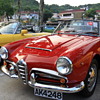Posted 11 years ago
 bohemiangl…
bohemiangl…
(648 items)
Delphi bears a resemblance to Candia Silberiris - both have an opaque silver/yellow iridescence, but the key marker for Delphi is in the color of the ground (yellow-green) vs. the colorless ground of Candia. Delphi also picks up shades of blue, whereas the Candia Silberiris vases I have seen seem to mix in shades of pink and/or purple. A perfect example of this contrast is found in Loetz Austria 1900, by Waltraud Neuwirth, where sample tiles from the factory (now in the collection at the MAK in Vienna) are shown opposite each other - one in Delphi, the other in candia Silberiris*. This vase, production number II-742, ca. 1900, is of the Delphi variety. The iridescence is nice and strong, with silver, yellow, and blue colors that really pop. Additionally, this vase has a very subtle design painted in etching ink - it can be seen better if you look at the large version of these photos. A clearer example of this pattern is found on the Loetz.com site in the decor index under DEK/DEK Etching Ink/Unknown Etching Ink. This vase is one of three examples shown there that share this as yet unidentified DEK pattern. It looks like there might be the remnants of DEK marking next to the polished pontil, but it is too weak to make out.
Acquired in a trade with a friend, I am very happy to have a true example of Delphi to add to my collection - it's a decor that has always puzzled me, and now that I have one to look at in person, I think I understand it much better.
*plates 211 and 212

































Warren, great information...great share!
I like your detailed description of this decor and comparison with Silberiris. Nice!
Thanks, Deb - now, if I can just figure out how to tell Norma apart from Silberiris...
To me Norma is easier than Delphi. Norma is more opaque and has more "pock" marks than Silberiris. I also usually see a spattering of darker spots (almost looks like a dull papillon) in the Norma examples.
Now you're gonna have me going through my cabinets looking for "pock marks' :)